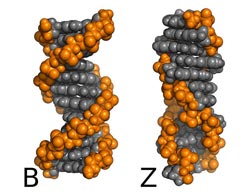New calculations solve an old problem with DNA

The normal (B-form) DNA will switch to left-handed (Z-form) DNA when it is physically twisted, or when a lot of salt is added to the solution. Researchers at the University of Luxembourg were able to accurately calculate for the first time the amount of salt which is required to do this.<br>Josh Berryman<br>
Researchers at the University of Luxembourg were able to accurately calculate for the first time the amount of salt which is required to do this. Z-DNA in the cell leads to loss of function and cancer.
It has been known since the seventies that excessive salt causes DNA to reverse its twist, from a right-handed spiral to a left-handed one. DNA in the Z form is treated by our natural repair enzymes as damaged, and is therefore usually deleted from the cell. Deletion of genetic material can lead to cancer or to other problems, so the B-Z transition is no mere curiosity. However such is the complexity of the DNA molecule that a theoretical explanation which correctly predicts the amount of salt to do this has never before been found.
Dr. Josh Berryman and Professor Tanja Schilling of the University of Luxembourg have now been able to find a method of calculation which predicts this transition with unprecedented accuracy. With this success in describing the most enigmatic of molecules, the team is optimistic that they will be able to perform similar mathematical analyses for a variety of other substances.
“It will enable us to predict material properties such as melting temperatures or elasticity. And this will be done with high accuracy using our new technique. Hence, we can now design new materials and biomaterials on the computer more effectively than before,” said Prof. Schilling.
Prof Schilling and Dr Berryman are physicists at the University’s Physics and Material Sciences Research Unit, which comprises a team of 50 researchers.
The paper entitled “Free Energies by Thermodynamic Integration Relative to an Exact Solution, Used to Find the Handedness-Switching Salt Concentration for DNA” was published in the Journal of Chemical Theory and Computation.
Media Contact
All latest news from the category: Physics and Astronomy
This area deals with the fundamental laws and building blocks of nature and how they interact, the properties and the behavior of matter, and research into space and time and their structures.
innovations-report provides in-depth reports and articles on subjects such as astrophysics, laser technologies, nuclear, quantum, particle and solid-state physics, nanotechnologies, planetary research and findings (Mars, Venus) and developments related to the Hubble Telescope.
Newest articles

Recovering phosphorus from sewage sludge ash
Chemical and heat treatment of sewage sludge can recover phosphorus in a process that could help address the problem of diminishing supplies of phosphorus ores. Valuable supplies of phosphorus could…

Efficient, sustainable and cost-effective hybrid energy storage system for modern power grids
EU project HyFlow: Over three years of research, the consortium of the EU project HyFlow has successfully developed a highly efficient, sustainable, and cost-effective hybrid energy storage system (HESS) that…

After 25 years, researchers uncover genetic cause of rare neurological disease
Some families call it a trial of faith. Others just call it a curse. The progressive neurological disease known as spinocerebellar ataxia 4 (SCA4) is a rare condition, but its…





















